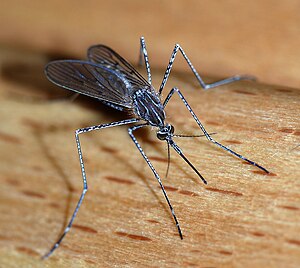 Image via Wikipedia
Image via WikipediaScientists believe they are closer to being able to change the DNA of wild mosquitoes in order to combat malaria.
In the laboratory, they made a gene spread from a handful of mosquitoes to most of the population in just a few generations, according to a report in Nature.
If the right gene can be made to spread then researchers hope to reduce the number of cases of malaria.
Other academics have described the study as a "major step forward".
The World Health Organisation estimated that malaria caused nearly one million deaths in 2008.
Spreading resistanceResearch groups have already created "malaria-resistant mosquitoes" using techniques such as introducing genes to disrupt the malaria parasite's development.
The research, however, has a great challenge - getting those genes to spread from the genetically-modified mosquitoes to the vast number of wild insects across the globe.
Unless the gene gives the mosquito an advantage, the gene will likely disappear.
Scientists at Imperial College London and the University of Washington, in Seattle, believe they have found a solution.
They inserted a gene into the mosquito DNA which is very good at looking after its own interests - a homing endonuclease called I-SceI.
The gene makes an enzyme which cuts the DNA in two. The cell's repair machinery then uses the gene as a template when repairing the cut.
As a result the homing endonuclease gene is copied.
It does this in such a way that all the sperm produced by a male mosquito carry the gene.
So all its offspring have the gene. The process is then repeated so the offspring's offspring have the gene and so on.
In the laboratory experiments, the gene was spread to half the caged mosquitoes in 12 generations.
Defeating malariaProfessor Andrea Crisanti, from the department of life sciences at Imperial College London, said: "This is an exciting technological development, one which I hope will pave the way for solutions to many global health problems.
"At the beginning I was really quite sceptical and thought it probably would not work, but the results are so encouraging that I'm starting to change my mind."
He said the idea had been proved in principle and was now working on getting other genes to spread in the same way.
He believes it could be possible to introduce genes which will make the mosquito target animals rather than humans, stop the parasite from multiplying in the insect or produce all male offspring which do not transmit malaria.
Professor Janet Hemingway, from the Liverpool School of Tropical Medicine, said the work was an "exciting breakthrough".
She cautioned that the technique was still some way off being used against wild mosquitoes and there were social issues around the acceptability of using GM technology.
"This is however a major step forward providing technology that may be used in a cost effective format to drive beneficial genes through mosquito populations from relatively small releases," she added.
Dr Yeya Touré, from the World Health Organisation, said: "This research finding is very important for driving a foreign gene in a mosquito population. However, given that it has been demonstrated in a laboratory cage model, there is the need to conduct further studies before it could be used as a genetic control strategy.
Taken from bbc.co.uk; source article is below:
GM mosquitoes offer malaria hope















